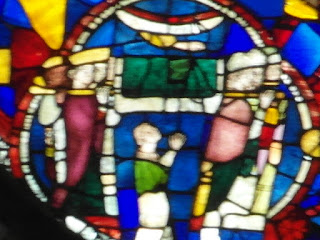Every so often, I'm reminded of why I love history and why I find historical novels, both reading and writing them, such a joy. This time the occasion was a visit to the lovely medieval city of Lincoln in England's fen country which brought home to me once more the romance of history and the sheer fun of discovered quirky little stories and details that had a big impact, or simply tell us interesting things about humanity.
 |
| Medieval stained glass window showing the burial of Hugh of Lincoln. |
Lincoln is a very old city, dating back to Roman times, but a cataclysmic earthquake in 1185 destroyed many of its buildings including all of the Norman cathedral apart from the West Front. After the disaster, King Henry II, still consume by guilt over the murder of Thomas Becket, sent for a monk called Hugh of Avalon, a Burgundian who was at the time the prior of a Carthusian monastery in Somerset. Hugh (later St Hugh) had the reputation of being a great administrator as well as a very devout man. On Henry's orders he set about rebuilding the cathedral with tremendous drive and vision. It was completed in the Gothic style and was regarded for a long time as the largest covered space in Europe.
A tour of the cathedral reveals many stories including the history of the Lincoln Imp, a gargoyle who watches you from his vantage point high in the vaulted ceiling. The story goes that in the 14th century, Satan sent two of his imps to Earth to do mischief. When they reached Lincoln Cathedral they started smashing up the pews and treasures and tripping up the bishop. When an angel appeared from a hymn book and told them to stop, one escaped, but the other was turned to stone.
 |
| The Lincoln Imp |
Centuries later, a Lincoln jeweller called James Usher made a tie pin in the shape of the imp and presented it to Edward VII (then still Prince of Wales) on his visit to Lincoln. Not long afterwards, Edward's horse Persimmon won the Derby. When admirers congratulated him, he pointed to the tie pin which he happened to be wearing and said all the credit for his luck should go to the imp. There was a mad rush to buy the tie pins and Usher became a millionaire! Subsequently, he founded the city's art gallery.
 |
| Edward VII with Persimmon |
Another interesting story associated with the cathedral is that of George Boole, the inventor of Boolean logic which is at the heart of most of the computer programming codes used today. He is regarded by some as one of the fathers of the computer. Boole married a niece of George Everest, the explorer and conqueror of the Himalayas, who seems to have had the same robust attitude to life as her uncle. When Boole caught a chill after walking to give a lecture at his university in a heavy rainstorm then remaining in his wet clothes, she decided that the thing that had made him ill should also be used to cure him. Possibly he would not have survived anyway but I feel that having buckets of icy water poured over him didn't help. His memorial stained glass window is in the cathedral's nave.
 |
| Memorial to George Boole |
Standing in the cathedral at Lincoln, I closed my eyes and imagined the sounds (and smells) of those medieval people who would have come through its doors to marvel at the great open space. The cathedral wasn't just a place of worship, it was a place where people met their friends, exchanged stories and even goods. If they had ridden to town on a valuable horse or had some other valuable animal with them, they might bring it in rather than leave it outside to be stolen.
Lincoln Cathedral is truly a place alive with the echoes and romance of history. I hope to have the chance to return.



No comments:
Post a Comment